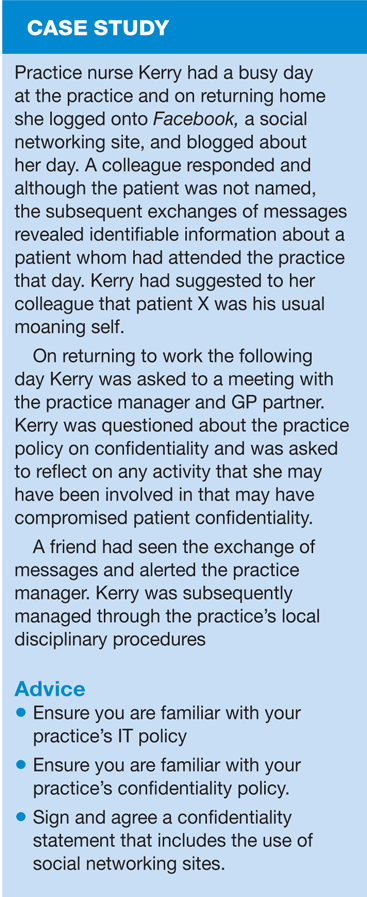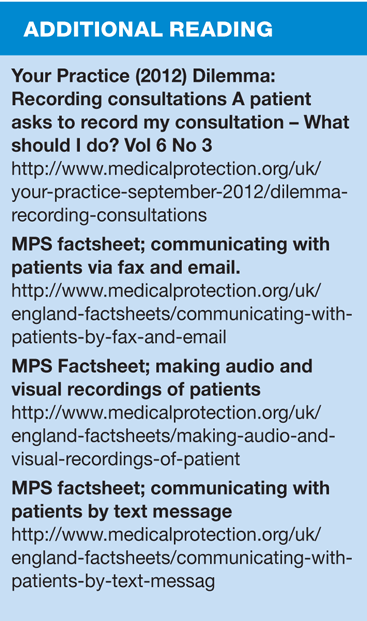Technology in general practice — is it a risky business?
Kate Taylor
Kate Taylor
RN, Clinical Risk Manager,
Medical Protection Society
Life in the 21st century is dominated by technology: we can access information at the click of a button, but is there a downside? Kate Taylor, a registered nurse and Clinical Risk Manager at the Medical Protection Society looks at the risks
Technology allows us to order shopping online, chat with friends and family via social networking sites, book holidays, download music, read books and so much more. So how has technology impacted on general practice? Many practices now send text messages to patients, offer online appointment booking, order repeat prescriptions electronically, provide service information on the practice website and encourage patient feedback online. Within practices there have also been big changes, with the introduction of electronic medical records and test results and electronic messaging between doctors.
POTENTIAL RISKS
The use of technology in a healthcare setting can come at a price and nurses need to be aware of the key risk areas affecting their role and the wider practice. Through the Clinical Risk Self Assessment (CRSA) programme MPS has identified emerging risks that general practice teams need to be mindful of, and to address proactively.1
1. COMMUNICATION
Nurses are increasingly seeing patients who have researched into illnesses or ailments they have, or think they have, and have used the Internet to access medical advice.
The Internet contains a vast spectrum of information: at one end there is controlled and reputable medical information, however at the other end there are uncontrolled websites of a commercial, personal or ideological disposition. Balancing these opposing sources presents medicolegal issues for nurses.
The Nursing and Midwifery Council Code states: 'You must listen to the people in your care and respond to their concerns and preferences.'2
This can prove challenging for practice nursing teams as patients become better informed and have raised expectations.
Risk management advice
- Ensure that you have effective communication skills including listening and empathy to assist the consultation
- Advise the patient about the limits on the reliability of material on the internet
- Be receptive to information from the Internet
- Be open to new means of communication, but manage them effectively
- Remind patients that there are constraints on your time and you can't necessarily read all the materials that they bring to the consultation
- Work within your competence
- Keep a record of the consultation in the patient's record.
The use of email has proven to be revolutionary in terms of improving communication, but although email is an attractive way for patients to communicate with the practice, safeguards are required in order to preserve patient confidentiality. Unless messages are encrypted, patients should be aware that their messages could potentially be read by someone else.
Risk management advice
- Always obtain and document consent from the patient to communicate with them by email
- Only appropriate matters should be dealt with via email exchanges, such as appointment scheduling, ordering repeat prescriptions and obtaining test results
- Develop a standard protocol for email exchanges to address situations such as patients asking for more complex information about medical symptoms or their proposed treatment by email, which would be difficult for the practice to respond to quickly and appropriately
- Ensure that all emails to and from the patient are included as part of the patient's medical record.
3. RECORDING CONSULTATIONS
It is becoming increasingly common for patients to ask to record a consultation on their phone, to share with a third party or possibly to publish on the Internet. While the nurse may feel that the presence of a recording device may hinder the nurse-patient relationship, they have a duty to assess the patient's condition and advise on any necessary treatment.
Risk management advice
- Any concerns about the recording, including managing the security of their confidential information, should be discussed with the patient beforehand
- Consider keeping a copy of the recording in the patient's medical record.
4. TEXT MESSAGING
Many practices are signing up to use a text messaging service to inform patients of appointments, flu vaccinations etc. Text messaging allows practices to contact hundreds of patients within minutes, and patients can respond by text with replies automatically forwarded to a specified email address.3
Risk management advice
- Ensure that text messages are as secure as possible and compliant with the relevant legislation and professional guidance
- Ensure explicit consent is obtained from patients prior to using text messaging as a form of communication
- Remember that text messaging in this context is a professional communication, hence 'text-speak' should be avoided.
5. SOCIAL NETWORKING SITES
Many practices have embraced social networking sites as an innovative way of communicating with patients but boundaries should be maintained when using social media in a nurse's personal life. This growing phenomenon has led to the Nursing and Midwifery Council (2012) developing clear guidance recommending that nurses ensure they use privacy settings when visiting such sites.4
Risk management advice
- Do not post anything you would not want others to see
- Do not discuss work-related issues online, including conversations about patients or complaints about colleagues
- Never post pictures of patients or service users, even if they ask you to do this
- Social networking sites should not be used for raising and escalating concerns
- Protect your own privacy.
6. RECORD KEEPING AND VISITS
Some nurses may recall the days when hand written clinical notes were the norm, now this is the exception except perhaps in the context of a home visit or when issuing a hand written prescription. Being computer savvy was not a prerequisite of becoming a nurse, and many nurses have self taught skills. In general practice most nurses will now be working with clinical computerised systems.
Risk management advice
- Ensure that you have received appropriate computer training including the use of the practice clinical system
- Maintain complete, contemporaneous patient records.
CONCLUSION
Technological advances will undoubtedly bring further changes and risks will never be eliminated entirely, however identifying and managing the risks early on will go a long way to providing a safer environment for patients.
REFERENCES
1. MPS Clinical Risk Self assessment
http://www.medicalprotection.org/uk/education-and-events/clinical-risk-self-assessments-for-GPs
2. NMC (2008) The code: standards of conduct, performance and ethics for nurses and midwives. London.
3. Using text messaging services: an RCN guide on using technology to complement nursing practice
http://www.rcn.org.uk/__data/assets/pdf_file/0003/450246/004_230_Using_text_messaging_V2.pdf
4.NMC (2012) The code: social networking advice
http://www.nmc-uk.org/Nurses-and-midwives/Advice-by-topic/A/Advice/Social-networking-sites
Related articles
View all Articles


